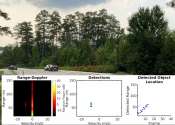Radar gets a major makeover
If radars wore pants, a lot of them would still be sporting bell-bottoms.
Jul 19, 2022
0
37
Software

If radars wore pants, a lot of them would still be sporting bell-bottoms.
Jul 19, 2022
0
37
Security

A black sedan cruises silently down a quiet suburban road, driver humming Christmas carols quietly while the car's autopilot handles the driving. Suddenly, red flashing lights and audible warnings blare to life, snapping ...
Jan 31, 2024
0
28
Other

The critically ill newborn baby was whisked by helicopter Saturday from rural Silverton, Oregon, to a children's hospital in Portland, the kind of life-saving transport Life Flight Network makes thousands of times a year.
Jan 14, 2022
0
103
Engineering

Researchers have developed a real-time approach that can help prevent incidents like the large-scale disruption at London's Gatwick Airport in 2018, where possible drone sightings at the perimeter of the airport caused the ...
Sep 15, 2021
0
14
Engineering

With the landing of a MA60 aircraft, a comprehensive remote sensing experiment wrapped up in Rizhao City, Shandong Province on November 30, 2021.
Dec 14, 2021
0
6
Hi Tech & Innovation

Artificial intelligence (AI) has sped up the process of detecting flooded buildings immediately after a large-scale flood, allowing emergency personnel to direct their efforts efficiently. Now, a research group from Tohoku ...
Apr 16, 2021
0
7
Robotics

Baseball fans know the bitter heartbreak of calls that don't go their way—especially, a ball that should've been a strike. And, with advances in technology including computer vision, artificial intelligence, and the ubiquity ...
Oct 28, 2021
0
41
Automotive

Intelligent Transportation Systems (ITS) need traffic data to run smoothly. At intersections, where there is the greatest potential for conflicts between road users, being able to reliably and intelligently monitor the different ...
Dec 3, 2021
0
137
Engineering

(Tech Xplore)—Bellevue, Washington-based Echodyne has announced the successful testing of a new type of radar system that is both smaller and less expensive than other radar systems currently in use. The new system, company ...
Automotive

A self-driving electric ferry set sail in Stockholm on Thursday, making the Swedish capital the world's first city to put the technology to use, the company behind it said.
Jun 8, 2023
0
26
Radar is an object detection system that uses electromagnetic waves to identify the range, altitude, direction, or speed of both moving and fixed objects such as aircraft, ships, motor vehicles, weather formations, and terrain. The term RADAR was coined in 1941 as an acronym for radio detection and ranging. The term has since entered the English language as a standard word, radar, losing the capitalization. Radar was originally called RDF (Radio Direction Finder, now used as a totally different device) in the United Kingdom.
A radar system has a transmitter that emits microwaves or radio waves. These waves are in phase when emitted, and when they come into contact with an object are scattered in all directions. The signal is thus partly reflected back and it has a slight change of wavelength (and thus frequency) if the target is moving. The receiver is usually, but not always, in the same location as the transmitter. Although the signal returned is usually very weak, the signal can be amplified through use of electronic techniques in the receiver and in the antenna configuration. This enables radar to detect objects at ranges where other emissions, such as sound or visible light, would be too weak to detect. Radar is used in meteorological detection of precipitation, measuring ocean surface waves, air traffic control, police detection of speeding traffic, and by the military.
This text uses material from Wikipedia, licensed under CC BY-SA